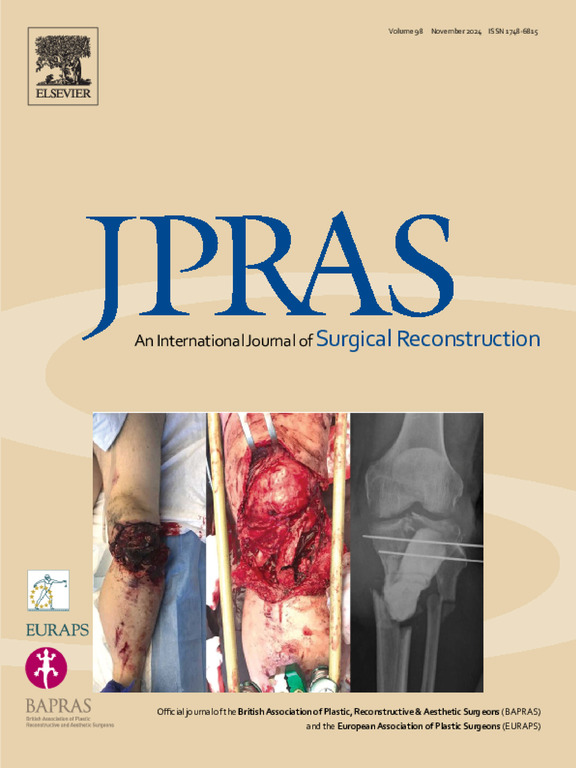3D-printed bioresorbable polycaprolactone-tricalcium phosphate implant for mandible reconstruction: A biomechanical in-vivo evaluation
IF 2.4
3区 医学
Q2 SURGERY
Journal of Plastic Reconstructive and Aesthetic Surgery
Pub Date : 2025-09-05
DOI:10.1016/j.bjps.2025.08.035
引用次数: 0
Abstract
Background
Large mandibular critical-sized defects commonly require free vascularized bone flaps. However, this procedure is associated with donor site morbidities and complex microsurgical procedures. An implant-based technique that can achieve similar reconstructive outcomes would be a valuable addition in a reconstructive surgeon’s armamentarium. This preliminary study evaluated 3D-printed polycaprolactone-tricalcium phosphate implant for reconstructing mandibular critical-sized defects using a porcine model.
Methods
Seven mandibular body critical-sized defects were created in 5 male Yorkshire-Landrace pigs (3 unilateral and 2 bilateral defects). These defects were reconstructed using polycaprolactone-tricalcium phosphate implants. The study endpoint was at 3 months. The reconstructed mandibular specimens were resected for evaluation. Ossification was evaluated using computed tomography scans and histology. Biomechanical strength was evaluated using the three-point bend test. The contralateral unoperated sides served as the controls.
Results
The animals retained normal mastication. All implants demonstrated ossification on computed tomography scans with a median of 24.1% (range 13.6–27.2%). Histological examination (using hematoxylin and eosin and Masson’s Trichrome stains) demonstrated new bone formation. The three-point bend test demonstrated a borderline significant difference in the maximum flexural force between the reconstructed mandibles and controls (p = 0.059), with a mean difference of 426.62 N (95% CI −16.57 to 869.81).
Conclusion
Using polycaprolactone-tricalcium phosphate implants in reconstructing mandibular critical-sized defects is safe and reliable. Polycaprolactone-tricalcium phosphate is bioresorbable, osteo-conductive, and osteo-inductive. It provides immediate functional restoration and mechanical strength under load-bearing situations.
用于下颌骨重建的3d打印生物可吸收聚己内酯-磷酸三钙植入物:生物力学体内评估
背景:大的下颌临界尺寸的缺损通常需要带血管的游离骨瓣。然而,这种手术与供体部位的发病率和复杂的显微外科手术有关。一种基于种植体的技术可以达到类似的重建效果,这将是重建外科医生装备中一个有价值的补充。本初步研究评估了3d打印聚己内酯-磷酸三钙种植体用于重建猪下颌骨临界尺寸缺损的效果。方法选取5头公约克长白猪,制造7个下颌骨临界尺寸缺损(3个单侧缺损,2个双侧缺损)。这些缺损采用聚己内酯-磷酸三钙植入体重建。研究终点为3个月。重建的下颌骨标本被切除进行评估。使用计算机断层扫描和组织学评估骨化。采用三点弯曲试验评估生物力学强度。对侧未手术侧作为对照。结果动物咀嚼功能保持正常。所有植入物在计算机断层扫描中显示骨化,中位数为24.1%(范围13.6-27.2%)。组织学检查(苏木精、伊红和马松三色染色)显示新骨形成。三点弯曲试验显示,重建下颌骨与对照组之间的最大弯曲力存在临界显著差异(p = 0.059),平均差异为426.62 N (95% CI为−16.57至869.81)。结论聚己内酯-磷酸三钙种植体修复下颌骨临界尺寸缺损安全可靠。聚己内酯-磷酸三钙具有生物可吸收性、骨导电性和骨诱导性。它提供即时功能恢复和机械强度在承重情况下。
本文章由计算机程序翻译,如有差异,请以英文原文为准。
求助全文
约1分钟内获得全文
求助全文
来源期刊
CiteScore
3.10
自引率
11.10%
发文量
578
审稿时长
3.5 months
期刊介绍:
JPRAS An International Journal of Surgical Reconstruction is one of the world''s leading international journals, covering all the reconstructive and aesthetic aspects of plastic surgery.
The journal presents the latest surgical procedures with audit and outcome studies of new and established techniques in plastic surgery including: cleft lip and palate and other heads and neck surgery, hand surgery, lower limb trauma, burns, skin cancer, breast surgery and aesthetic surgery.

 求助内容:
求助内容: 应助结果提醒方式:
应助结果提醒方式:


